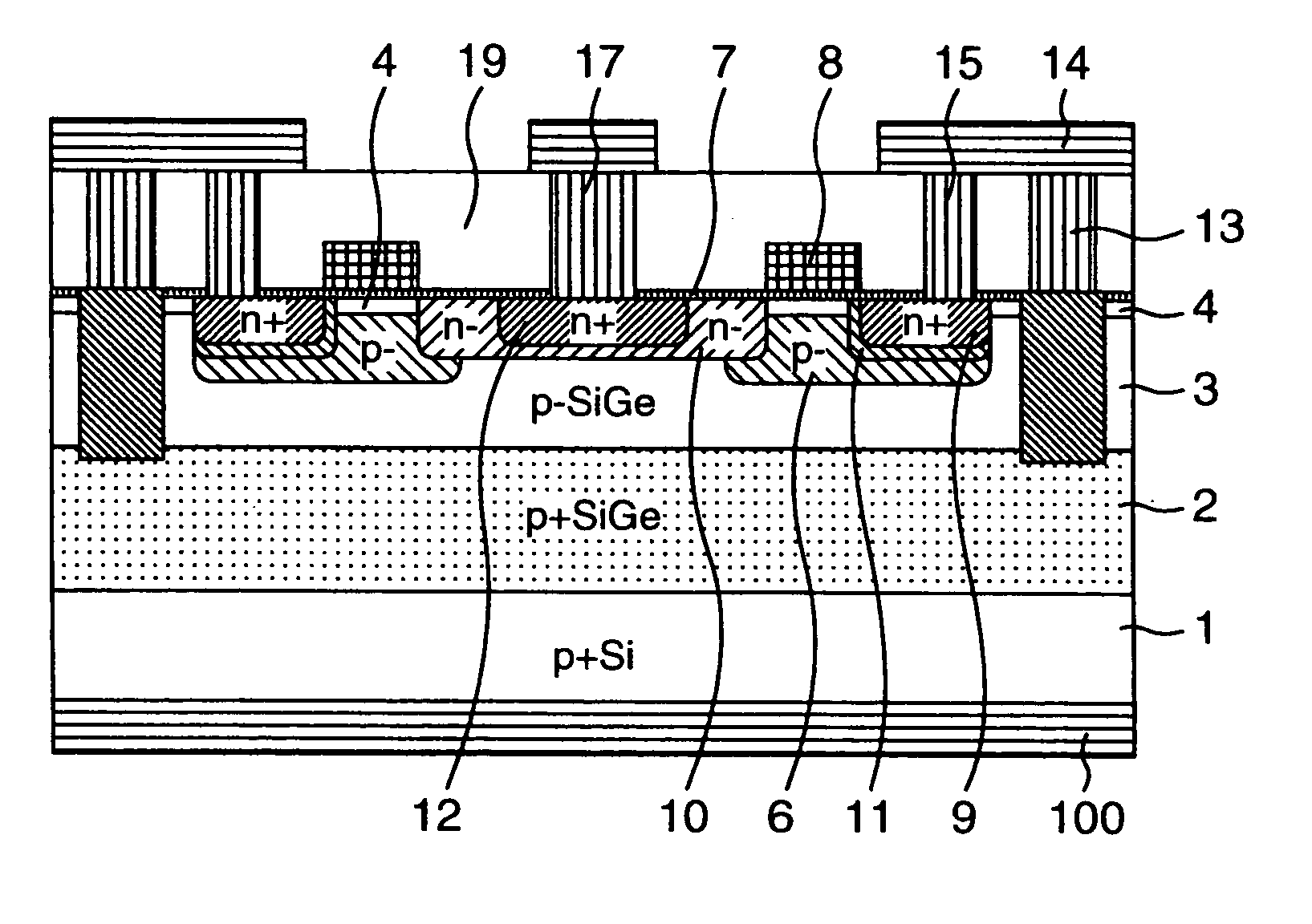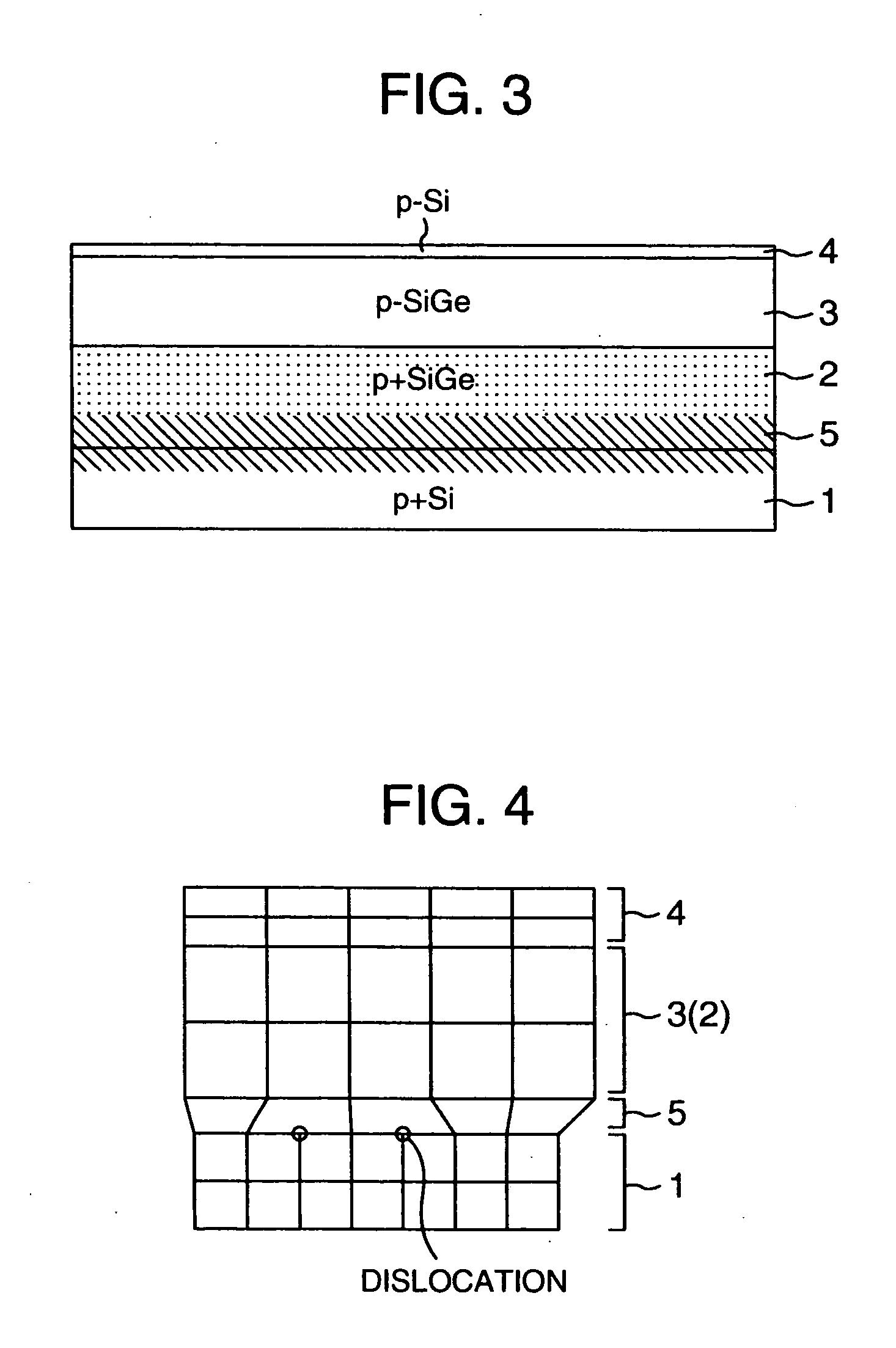Field-effect type semiconductor device for power amplifier
a power amplifier and field-effect technology, applied in semiconductor devices, amplifiers with semiconductor devices/discharge tubes, semiconductor devices, etc., can solve the problems of reducing the mobility of carriers, reducing the efficiency of wafers, and reducing the cost of wafers. the effect of reducing leakage current, improving carrier mobility, and improving transcopniductan
- Summary
- Abstract
- Description
- Claims
- Application Information
AI Technical Summary
Benefits of technology
Problems solved by technology
Method used
Image
Examples
embodiment 1
[0035] In the present embodiment, an N-channel field-effect type semiconductor device is exemplified in which a channel is formed in a Si layer formed on a SiGe layer.
[0036]FIG. 1 is a longitudinal sectional view of essential part of an N-channel field-effect type semiconductor device according to the present embodiment and FIG. 2 is a plan view of the N-channel field-effect type semiconductor device. Specifically, the FIG. 1 sectional view shows a section taken on line I-I in FIG. 2. Prior to giving a description with reference to FIGS. 1 and 2, a semiconductor multi-layer structure used in the fabrication of the field-effect semiconductor device of embodiment 1 will be described by making reference to FIGS. 3 and 4.
[0037] As shown in FIG. 3, in the semiconductor multi-layer structure used in the fabrication of the field-effect type semiconductor device according to embodiment 1, a P-type low-resistance first SiGe layer 2, a P-type high-resistance second SiGe layer 3 and a P-type...
embodiment 2
[0057] In the present embodiment, there is exemplified a P-channel field-effect type semiconductor device in which a channel is formed in a Si layer formed on a SiGe layer. The fabrication process extremely resembles that in the case of embodiment 1 and only different points will be described.
[0058] The semiconductor multi-layer structure shown in FIG. 3 is structurally altered in the present embodiment to have an N-type low resistance Si substrate 1, an N-type low resistance first SiGe layer 2, an N-type high resistance second SiGe layer 3 and an N-type high resistance Si layer 4. As a doping gas, PH3 is used in place of the B2H6 and the impurity concentration is similar to that in embodiment 1.
[0059] The well region 6 and punch-through stopper 11 are of N-type and for them, P is implanted in place of B. Each of the source region 9, drain region 12 and drain offset region 10 is of P-type and for its formation, B or BF2is implanted. The ion implantation depth and implantation quan...
embodiment 3
[0061] In the present embodiment, a P-channel field-effect type semiconductor device will be exemplified in which a channel is formed near an interface to Si layer 4 inside the second SiGe layer 3. The fabrication process extremely resembles that in embodiment 2 and only different points will be described.
[0062] When, in the foregoing semiconductor multi-layer structure, the thickness of Si layer 4 is set to 15 nm, the thickness of the Si layer 4 in a channel region of a completed field-effect transistor is less than 5 nm and as a result, the channel is not formed in the Si layer 4 but is formed near an interface to Si layer 4 inside the second SiGe layer 3.
[0063] In the present transistor the hole mobility in the second SiGe layer 3 is 2.1 times increased to advantage as compared to that of the ordinary Si field-effect transistor and the transconductance is improved by 90% as compared to the conventional transistor to 75% improve the power added efficiency of power amplifier circ...
PUM
 Login to View More
Login to View More Abstract
Description
Claims
Application Information
 Login to View More
Login to View More - R&D
- Intellectual Property
- Life Sciences
- Materials
- Tech Scout
- Unparalleled Data Quality
- Higher Quality Content
- 60% Fewer Hallucinations
Browse by: Latest US Patents, China's latest patents, Technical Efficacy Thesaurus, Application Domain, Technology Topic, Popular Technical Reports.
© 2025 PatSnap. All rights reserved.Legal|Privacy policy|Modern Slavery Act Transparency Statement|Sitemap|About US| Contact US: help@patsnap.com



